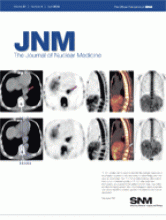TO THE EDITOR: With excitement did we read the article “Comparison of Imaging Protocols for 18F-FDG PET/CT in Overweight Patients: Optimizing Scan Duration Versus Administered Dose” by Masuda et al. (1).
With the increasing prevalence of overweight patients who undergo PET, the weight-related deterioration of image quality becomes an increasing problem in daily work in nuclear medicine. As the first prospective study to investigate optimization of PET/CT technique in overweight patients, this study draws attention to the diagnostic imaging round. The results suggest that only prolonged scanning can maintain the quality of images of heavier patients.
These results seem promising, but certain questions need clarification.
First, the “heaviest group” of patients was defined as weighing 85 kg or more. Today, especially in Western industrialized countries, such a weight is nearly average. At our institution, we encounter patients weighing far over 150 kg on a daily basis (2). A further division of the last category would have been desirable—for example, a division according to the guidelines of the National Institutes of Health, whereby a body mass index (BMI) of 25–29.9 kg/m2 is classified as overweight, 30–39.9 kg/m2 as obese, and 40 kg/m2 or more as malignantly obese (2).
Second, it does not seem useful to apply an absolute weight as the parameter of choice. A tall but skinny person can weigh more than a short but overweight person. A study from 1994 (3) suggested that the use of body surface area (BSA) is preferable to body weight correction. However, a more recent study (4) suggested that BMI is a better variable than body weight and BSA, as BMI appeared to be a more independent variable than height, weight, and BSA. The reasons may be that BMI better reflects the mass distribution and “radius” of the patient, which is ultimately the culprit in attenuation and image deterioration. BMI is easy to measure and can easily be integrated into the protocol process.
Lastly, the authors suggested that the noise-equivalent counting rate is linearly proportional to the dose and gave the dose-dependent groups up to a 2.5-fold–corrected dose for 90-kg subjects (832 MBq)—a dose that is excessive and likely to saturate counting rates anyway. This fact was admitted even by the authors themselves: “the optimal dose for attaining 90% of peak SNR in 90-kg subjects was estimated to be 529 MBq. In the current study, the 2.5-fold–corrected dose for 90-kg subjects was 832 MBq. Thus, an administered dose with a 2.5-fold correction is excessive and likely to saturate counting rates.” Above this saturation dose level, scatter photons play an increasing role and have a greater influence on the total counts.
Footnotes
-
COPYRIGHT © 2010 by the Society of Nuclear Medicine, Inc.







